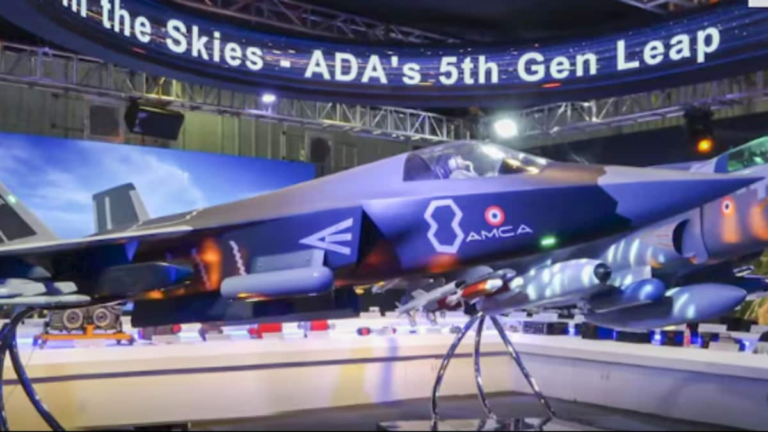Last updated:October 16, 2025, 13:14 IST
The fifth-generation fighter will be equipped with India’s indigenous Uttam-AESA radar to detect fighter-sized targets from distances of over 150 km, enhancing first-sight, first-strike capabilities.

AMCA will also feature an AI-powered multi-sensor data fusion system and infrared search and tracking. (PTI/File)
India has launched an ambitious project to develop a fifth-generation stealth fighter jet, marking a major step in strengthening national security. Alongside missile production, the country has also made great strides in ultra-modern air defense systems, accelerating indigenization across the defense sector.
The Advanced Medium Combat Aircraft (AMCA) project aims to develop a fighter jet that is nearly undetectable by modern radar systems and represents a strategic win for India. This development will deter countries like China and Pakistan from infiltrating India’s borders.
With the introduction of this indigenous fifth generation fighter jet, India will join an elite group of nations like the US, Russia and China. The Indian Air Force (IAF) plans to procure 120 of these fighter jets developed under the AMCA project.
India’s Advanced Medium Combat Aircraft (AMCA) program has reached a critical stage. This is the country’s first indigenous stealth fighter concept and is currently nearing production. Defense sources revealed that around 120 AMCA fighter jets will be produced for the IAF in the initial phase, with deliveries expected to begin in 2035.
The AMCA project aims to develop an aircraft that can carry out deep strikes without being detected by enemy radars. According to reports, two versions are in development. The first AMCA MK-1 will be powered by the American GE F414 engine. The second AMCA MK-2 is equipped with a 120kN thrust engine jointly developed by India and France’s Safran. The joint engine development project will cost $7.2 billion (approximately Rs. 60,000 crore) and will give India full technology transfer and intellectual property rights.
Main characteristics of 5th generation aircraft
The fighter jets developed under AMCA will be powered by two engines of 25 tons each.
Maximum Speed: 2600 KMPH (Mach 2.15) Combat Range: 1620 km Ferry Range: 5324 km Cruising Limit: 20000 meters (65,000 ft) Load Capacity: 6500 Kg
How much will 120 fifth-generation domestically produced fighter jets cost?
According to a report in India Defense News, each fighter jet in the project is expected to cost $140 million (approximately Rs. 1,228 crore). The IAF plans to purchase 120 jets, with a total cost of around $18 billion or Rs 1,57,844 million. This acquisition will significantly strengthen the IAF’s military capabilities. Additionally, a 4.5 generation fighter is also being developed under the Tejas fighter project.
Unique avionics and sensor fusion
The fifth-generation fighter jet developed under AMCA is equipped with India’s indigenous Uttam AESA radar, which can detect fighter-sized targets at distances of more than 150 km. It will also feature an AI-powered multi-sensor data fusion system, infrared search and track (IRST), and an integrated vehicle health monitoring system. This technology provides pilots with “first look, first kill” capabilities, allowing them to target the enemy before they can react.
AMCA project complete schedule
2025-2027: Prototype production and system integration 2028-2029: First flight and initial testing 2030-2034: Testing and certification 2035 and beyond: Production and Air Force induction
Integration of indigenous weapon systems
AMCA’s internal arsenal system was redesigned to carry six Astra MK-2 missiles without compromising stealth capabilities. Additionally, the fighter jet will be equipped with the Indian-developed BrahMos-NG supersonic cruise missile, SANT anti-tank missile, and Rudram anti-radiation missile.
The Ministry of Defense has approved a competitive industry partnership model involving not only HAL (Hindustan Aeronautics Limited) but also private companies such as TATA Advanced Systems, Adani Defense, L&T, Bharat Forge and Goodluck India. This is expected to improve production speed and quality.
Steps to make India an aerospace power
AMCA is more than just a fighter jet, it is a huge leap towards India’s self-reliant defense capabilities. The project is fostering an industrial ecosystem that will not only make India self-reliant in the coming years but also position it as a global aerospace player.
The success of the project will depend on India’s ability to effectively manage budgetary discipline, technical risks, and industry coordination. The induction of the first AMCA fighter into the IAF fleet in 2035 will be a defining moment in India’s defense history.
October 16, 2025, 13:14 IST
read more


